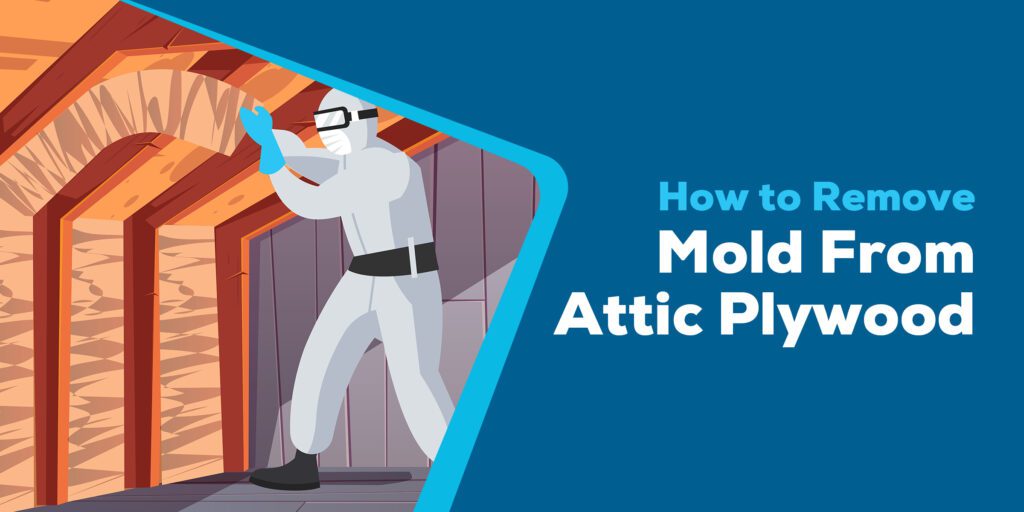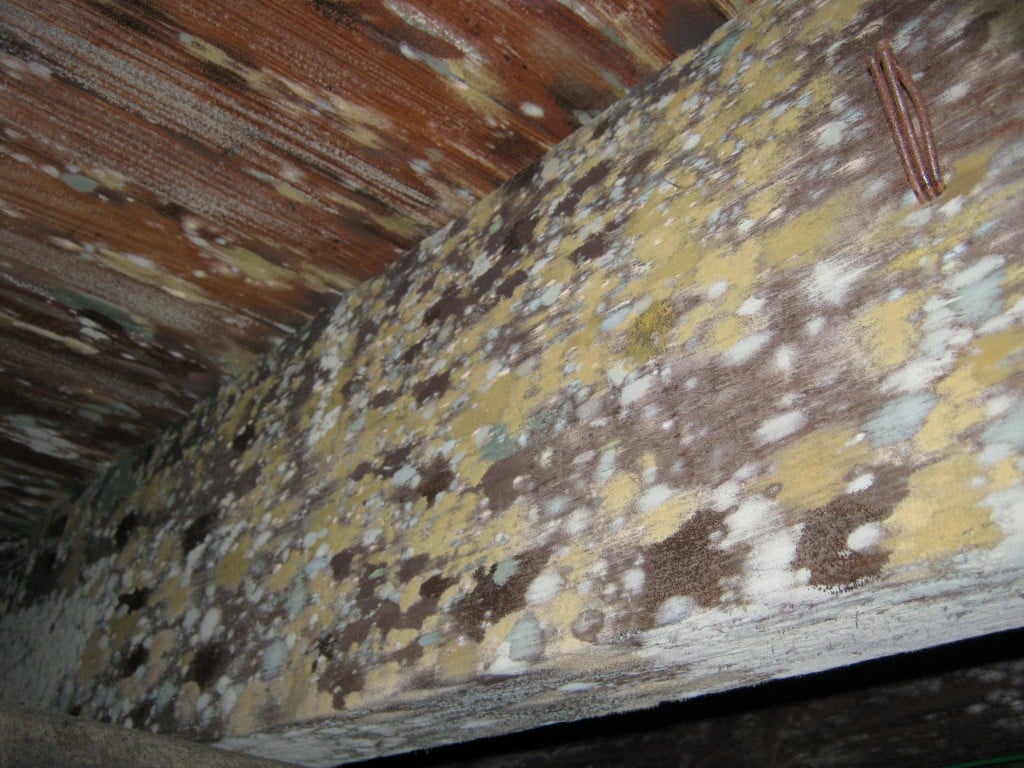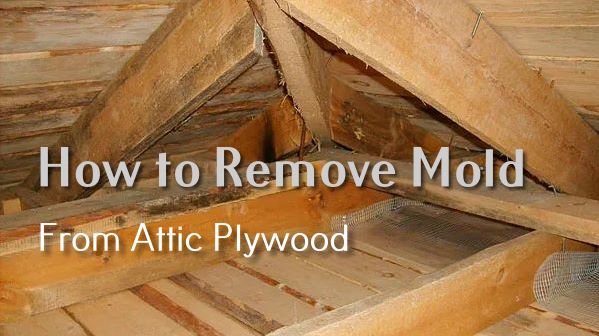In this article, we will discuss the essential steps to remove mold from attic plywood. Mold can be a common issue in attics, and it poses health risks and can damage the structure of your home. We will walk you through the process of identifying, containing, and removing the mold safely and effectively. With these steps, you can ensure a healthy and mold-free attic space.

Understanding Mold
Mold is a common problem that affects many homes, including attics. It is a type of fungus that thrives in warm, moist environments and can cause various health issues if left untreated. In this article, we will explore what mold is, common types of mold, why it is a problem in the attic, and how to identify mold on attic plywood.
What is Mold?
Mold is a type of fungus that can grow both indoors and outdoors. It reproduces by releasing tiny spores into the air, which can settle on surfaces and grow under suitable conditions. Mold requires moisture and organic material, such as wood or drywall, to thrive. It can appear in various colors, including black, green, or white, and has a fuzzy or slimy texture.
Common Types of Mold
There are several types of mold that commonly occur in homes. Some of the most common types include:
-
Cladosporium: This type of mold is typically green or black in color and can grow on surfaces such as carpets, fabrics, and wood.
-
Aspergillus: Aspergillus molds can appear in various colors, including yellow, green, white, or black. They commonly grow on walls, insulation, and paper products.
-
Stachybotrys: Also known as black mold, Stachybotrys can have a slimy texture and usually appears black or dark green. It thrives in areas with excessive moisture, such as leaky roofs or plumbing.
Why Mold is a Problem in the Attic
Attics are particularly prone to mold growth due to the specific conditions present in these spaces. Poor ventilation, inadequate insulation, and roof leaks can create a perfect environment for mold to thrive. Since attics are often dark, warm, and humid, it becomes an ideal breeding ground for mold. Mold growth in the attic can contaminate the air circulating in your home, leading to potential health problems for you and your family.
Identifying Mold in Attic Plywood
Now that we understand what mold is and why it is a problem in the attic, let’s discuss how to identify mold on attic plywood.
Visual Signs of Mold
One of the most obvious signs of mold on attic plywood is visible growth. You may notice dark or discolored patches on the plywood surface. Mold can appear fuzzy, slimy, or powdery. If you see any of these signs, it is likely that you have a mold problem in your attic.
Musty Odor
Another indicator of mold in the attic is a musty odor. Mold has a distinct smell that is often described as earthy or damp. If you notice a persistent musty smell in your attic, it is a strong indication that mold is present.
Health Symptoms Caused by Attic Mold
If you or your family members are experiencing health symptoms that worsen when spending time in the attic, it could be due to mold exposure. Common health issues caused by mold include respiratory problems, allergies, nasal congestion, sneezing, coughing, and skin rashes. If you suspect that mold in your attic is affecting your health, it is vital to take immediate action to remove it.
Preparation and Safety Measures
Before embarking on the mold removal process, it is essential to take the necessary precautions to protect yourself and your home. Here are some preparation and safety measures you should follow:
Gathering Necessary Tools and Supplies
To effectively remove mold from attic plywood, you will need the following tools and supplies:
- Protective gloves
- Safety goggles
- Respirator or face mask
- Scrub brush or sponge
- Bucket
- Mold removal solution or a mixture of water and detergent
- Vacuum cleaner with a HEPA filter
- Plastic sheets or tarps
- Duct tape
Having these items ready before you start the process will ensure that you can work efficiently and safely.
Wearing Protective Gear
When dealing with mold, it is crucial to protect yourself from exposure. Mold spores can cause allergic reactions and respiratory issues, so wearing protective gear is essential. Put on gloves, safety goggles, and a respirator or face mask to prevent the inhalation of mold spores.
Ensuring Proper Ventilation
Proper ventilation is crucial during the mold removal process to minimize the spread of mold spores. Open windows and doors in the attic to allow fresh air to circulate. Additionally, consider using fans or dehumidifiers to help dry out the space.
Isolating the Area
Before starting the mold removal process, it is essential to isolate the affected area. Cover adjacent surfaces with plastic sheets or tarps and secure them with duct tape. This will help prevent the spread of mold spores to other areas of your home.
Removing Mold from Attic Plywood
Now that you have taken the necessary safety precautions, let’s delve into the steps involved in removing mold from attic plywood.
Removing Damaged Insulation
Before cleaning the affected area, it is essential to remove any damaged insulation. Mold can grow on insulation, and contaminated insulation should be discarded and replaced. Carefully remove the insulation, placing it in plastic bags for disposal.
Cleaning the Affected Area
Once the damaged insulation is removed, it’s time to clean the affected area. Start by vacuuming the surface using a vacuum cleaner with a HEPA filter to trap mold spores. Dispose of the vacuum bag or clean the canister thoroughly to prevent the spores from spreading.
Next, dampen a scrub brush or sponge with a mold removal solution or a mixture of water and detergent. Gently scrub the moldy plywood, paying close attention to all visible mold growth. Be sure to reach any crevices or corners where mold may be hiding.
Using Mold Removal Products
If the mold growth is severe, you may consider using commercial mold removal products. These products are specifically designed to eliminate mold and prevent its regrowth. Follow the instructions on the product label and use it as directed. Remember to wear protective gear and ensure proper ventilation while using these products.
Scrubbing and Disinfecting the Plywood
After cleaning the moldy plywood, it is crucial to disinfect the surface to kill any remaining mold spores. Use a solution of bleach and water, following the appropriate dilution ratio. Apply the disinfecting solution to the plywood using a spray bottle or sponge, focusing on areas with visible mold. Allow the solution to sit for several minutes to effectively kill the mold, then rinse the surface thoroughly with clean water.

Preventing Future Mold Growth
Removing mold from attic plywood is just the first step in maintaining a healthy space. Here are some essential measures to prevent future mold growth in your attic:
Fixing Roof Leaks and Ensuring Proper Ventilation
Locate and repair any roof leaks promptly. Inspect your attic regularly for signs of water damage, such as discolored spots or dampness. Properly sealing and insulating your attic will also help prevent moisture buildup. Ensure that your attic has proper ventilation, allowing for the circulation of fresh air.
Insulating the Attic Properly
Inadequate insulation can lead to temperature fluctuations that promote mold growth. Insulate your attic properly to maintain stable temperatures and prevent condensation. Consult a professional if you are unsure about the appropriate insulation for your attic.
Controlling Moisture Levels
Excessive moisture is a leading cause of mold growth. Keep the humidity levels in your home below 50% to inhibit mold growth. Use dehumidifiers if necessary and fix any plumbing leaks promptly. Properly vent appliances that produce moisture, such as dryers or bathroom exhaust fans, to the outside.
Professional Mold Remediation
In some cases, it may be necessary to seek professional help for mold remediation. Consider hiring a reputable mold remediation company if:
- The mold growth is extensive and covers a large area.
- The mold is causing severe health symptoms.
- You are unsure about the proper removal techniques.
- The attic has structural damage that needs repair.
Professional mold remediation companies have the expertise and specialized equipment to handle mold problems effectively. Research and choose a reputable company that has experience in attic mold remediation.
Benefits of Hiring Professionals
Hiring professionals for mold removal in your attic offers several benefits. They have the knowledge and experience to effectively remove mold, ensuring that it does not return. Professionals can also identify the root cause of the mold growth and provide recommendations to prevent future issues. Additionally, hiring professionals saves you time and effort, allowing you to focus on other tasks while they handle the mold remediation process.

Health Risks and Precautions
Mold exposure can pose various health risks. It can trigger allergies, aggravate asthma symptoms, and cause respiratory problems. When removing mold from attic plywood, it is essential to take the following precautions to protect yourself:
Potential Health Risks of Mold Exposure
Exposure to mold can lead to a range of health issues. Some individuals may be more susceptible to mold-related health problems, such as:
- Allergic reactions, including sneezing, runny nose, and itchy eyes.
- Respiratory problems, such as coughing, wheezing, and difficulty breathing.
- Asthma attacks, especially in individuals with asthma.
- Skin irritation or rashes.
- Headaches, fatigue, and dizziness.
Protecting Yourself During Mold Removal
To protect yourself during the mold removal process, follow these precautions:
- Wear gloves, safety goggles, and a respirator or face mask to prevent inhalation of mold spores and contact with the skin.
- Work in a well-ventilated area and keep windows and doors open if possible.
- Avoid stirring up mold spores by gently cleaning the affected area without excessive agitation.
- Take regular breaks and ensure you have proper ventilation to minimize exposure to mold spores.
- Wash your hands and clean all tools and equipment thoroughly after the mold removal process.
Seeking Medical Advice
If you or your family members experience severe health symptoms or have concerns about the impact of mold exposure, it is advisable to seek medical advice. A healthcare professional can evaluate your symptoms and provide appropriate guidance.
Cleaning and Disposing of Moldy Materials
During the mold removal process, it is essential to properly clean and dispose of moldy materials to prevent further contamination. Here are some guidelines to follow:
Properly Cleaning Moldy Tools and Equipment
After completing the mold removal process, clean all tools and equipment thoroughly to remove any mold spores. Scrub brushes, sponges, and other reusable items should be washed with hot, soapy water. If necessary, use a mold removal solution or a mixture of bleach and water to disinfect the tools. Allow them to dry completely before storing or reusing.
Disposing of Moldy Materials Safely
Mold-contaminated materials should be disposed of properly to prevent the spread of mold spores. Place all moldy materials, such as damaged plywood or insulation, in heavy-duty plastic bags. Seal the bags tightly and dispose of them following the guidelines provided by your local waste management authorities. Avoid carrying moldy materials through your home to prevent accidental spreading of spores.

Maintaining a Healthy Attic Space
Regular maintenance and proper care are crucial for maintaining a healthy attic space. Here are some essential steps to follow:
Regular Inspections and Maintenance
Perform regular inspections of your attic to identify and address any potential issues promptly. Look for signs of water damage, leaks, or mold growth. Check the condition of the insulation and ensure that it is properly installed.
Monitoring Humidity Levels
Maintain optimal humidity levels in your attic to prevent mold growth. Use a humidity monitor or hygrometer to measure the humidity and keep it below 50%. If the humidity levels are consistently high, consider using a dehumidifier to reduce moisture.
Promoting Air Circulation
Proper air circulation is crucial for preventing mold growth. Allow fresh air to flow through your attic by opening windows, using fans, or installing attic vents. This will help regulate humidity levels and prevent stagnant air.
Conclusion
Removing mold from attic plywood is essential for creating a healthy living space. Understanding what mold is, how to identify it, and the necessary steps for removal is key to maintaining a mold-free environment. By following the essential steps outlined in this article, you can effectively remove mold from attic plywood and prevent future mold growth. Remember to prioritize safety, seek professional help if needed, and maintain regular inspections to ensure a healthy attic space. By taking these measures, you can enjoy a mold-free and comfortable home.
